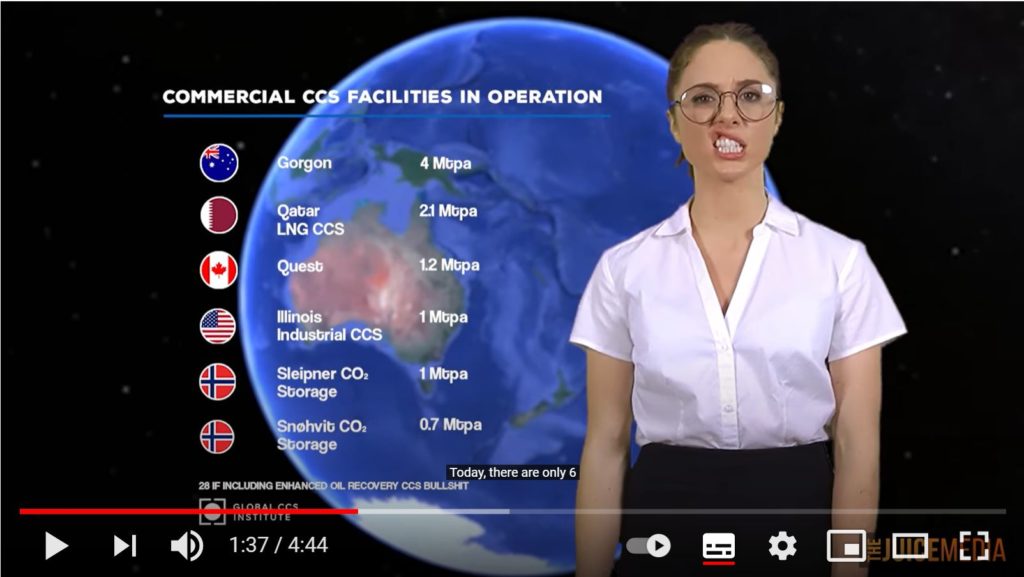
“CCS is a complex mining process whereby fossil fuel companies inject donations into the…”
This critique of CCS by @thejuicemedia is as good you will ever find. And quite educational to boot…https://t.co/ThruxaVb3L pic.twitter.com/aXB7eQSViy
— Glen Peters (@Peters_Glen) September 3, 2021
Ministry of Petroleum and Energy:
The Norwegian government has launched the full scale CO2 capture, transport and storage project ‘Longship’. The project was approved by the Norwegian parliament in the state budget for 2021. The total cost estimate is NOK 25.1 billion. Longship will receive state aid in accordance with negotiated agreements. The state’s part of these costs are estimated at NOK 16.8 billion.
What is Carbon Capture and Storage (CCS)?
Why Carbon Capture and Storage (CCS)?
CCS is short for carbon capture and storage and refers to the capturing, transporting and storage of CO₂. In English we use the word Carbon Capture and Storage (CCS), and this acronym is also frequently used in Norwegian.
CCS is a tool to limit the amount of CO₂ emitted to the atmosphere by capturing CO2 and thereafter storing it safely for example in underground geological formations. According to the Global CCS Institute (GCCSI), there are currently 19 large scale projects in operation and four new projects in construction with a total capacity close to 40 million tonnes of CO₂.
CO₂ Capture
CO₂ can be captured from flue gases, from power plants and industrial processes.
CO₂ is a natural component in natural gas and can be separated from the rest of the gas as part of the gas treatment process needed in order to achieve necessary quality of the natural gas. Capturing CO₂ from low pressure flue gases from power plants or industrial processes is more difficult and energy intensive than capturing CO₂ from high pressure natural gas.
There are several different technologies available for capturing CO₂ from flue gases and a few of these have been and are currently being tested at the Technology Centre Mongstad (TCM). More information about different capture technologies can be found at the Gassnova webpages.
CO₂ Transport
CO₂ can be transported in pipelines or in tanks on ships and trucks. Which alternative to choose depends generally on the amount of CO₂ to be transported and the distance between capture site and storage facility. Typically transport by ship is favourable for not too large CO₂ amounts and fairly long distances. Pipeline transport is normally more suitable for larger amounts of CO₂ and somewhat shorter distances.
CO₂ storage
It is possible to safely store large amounts of CO₂ on the Norwegian continental shelf. In Norway we are only looking at CO2 storage offshore below the sea bed. On the continental shelf we have access to large geological formations of depths where amongst others favourable pressure and temperature conditions prevent CO₂ from migrating through layers of sand and rock towards the surface. The Petroleum Directorate has developed a storage atlas that gives an overview of possible storage locations on the Norwegian continental shelf.
Why do we spend large amounts of money on CCS in Norway?
Norway wants to contribute to reducing the global greenhouse gas emissions. The government therefore wants to contribute to developing CCS technology that can be shared internationally. In order to achieve the required amount of CCS projects needed, the technology has to be further developed and costs have to come down. Currently CCS is too costly for commercial industry to tackle the development on their own. Norway has good capabilities in technology development and we have strong experience in safely storing CO2 underground. This puts us in a good position to contribute to the development of CCS globally.
Longship
Approval of plans for CO2-storage
Press release | Date: 09/03/2021| No: 014/21
The Ministry of Petroleum and Energy has approved the development plan for Northern Lights, which is the storage part of the Longship project. The final state support agreements with the companies were signed before the weekend.

— In January, the Norwegian Parliament endorsed Longship, which is the biggest climate project in Norwegian industry ever. The project will cut emissions, and facilitate value creation and new jobs. The goal is also that it will contribute to increased use of CO2 capture and storage internationally. With the approval of the development plan for the storage part of the project, Northern Lights, a new milestone has been passed, says Tina Bru, Minister of Petroleum and Energy.
Northern Lights will receive captured CO2 transported on ship to Øygarden municipality on the western coast of Norway. Here, the gas will be temporarily stored before it is sent through a pipeline to the storage site on the continental shelf. At the storage site CO2 is pumped down to a sealed reservoir for permanent storage 2600 meters below the seabed. The reservoir is located in utilisation permit 001 in the northern part of the North Sea, southwest of the Troll field and east of the Oseberg field.

Tina Bru, Minister of Petroleum and Energy will today celebrate the approval of the development plan and the launch of the company Northern Lights JV DA in a digital event today at 1200 CET. The meeting can be followed here.
The licensee has estimated the total investment under the development plan to close to six billion kroner, and annual operating costs at around 370 million kroner. The approved plan has the capacity to store 1,5 million tonnes CO2 annually, and a planned operation period of 25 years. The letter of approval can be read here (in Norwegian only).
The Storting approved state support to Longship in December, in line with the Government’s proposal.
Northern Lights will be built and operated by the company Northern Lights JV DA, which is backed by Equinor, Norske Shell and Total E&P Norge. A prerequisite for this is a participation agreement between the three companies which must be approved by the Ministry.
The storage is planned with a capacity to store more CO2 than what is to be captured through the Longship project. The approved development plan includes on injection well. A potential extra injection well, as well as a potential future phase two for the storage projects, will require a new government approval.

Northern Lights is in dialogue with several European entities regarding possible use of the storage. It is an important goal for the government to lower the cost of carbon capture and storage, and that more projects will follow after Longship.
— The outlook is good. Northern Lights has already signed MoUs with eight companies, and I believe more will want to connect to the storage now that the project has been approved, says Tina Bru.
The Longship project also provides inspiration for other industry actors. Heidelberg Cement, which owns Norcem, is now considering a capture project on a cement factory in Gotland, Sweden. The facility has the potential to capture more than four times as much as in the project at Norcem.
Important milestones have been passed
After several years of negotiations state support agreements were signed earlier this year between the Norwegian government and the capture agents Norcem and Fortum Oslo Varme. The agreement with Fortum Oslo Varme is on the condition that the company secures sufficient financing from the EU or other sources.
The agreement with Northern Lights was signed 5 March. Together, the agreements that now are signed give the companies in the whole chain from capture to storage strong incentives to build and operate the projects effectively, in a way that contributes to Norway and Europe reaching their climate targets. To secure income, the capture companies must capture CO2 efficiently, while Northern Lights must sell additional capacity to other customers.
— We have made a business model where the companies must succeed commercially to recover their shares of the investments. The companies’ efforts will therefore support the government’s ambitions for Longship: To develop a cost-effective solution for CCS which contributes to Norway and Europe reaching their climate targets, says Tina Bru.
Construction work is now proceeding in Øygarden, where the CO2 terminal is located. The minister will be given a virtual tour of the construction site in Øygarden in today’s event. Also at Norcem’s factory in Brevik construction work has started.Ministry of Petroleum and Energy
RELATED
- Funding for Longship and Northern Lights approvedPress release | 15.12.2020
- The Government launches ‘Longship’ for carbon capture and storage in NorwayPress release | 21.09.2020
- Meld. St. 33 (2019–2020) – Longship – Carbon capture and storage




37 Comments
Pingback: Why the oil industry’s pivot to Carbon Capture and Storage (CCS) – while it keeps on drilling – isn’t a climate change solution - Bergensia
Pingback: Testosteron Cypionat Kaufen
Pingback: 다시보기사이트
Pingback: sudoku
Pingback: โฉนดที่ดินเข้าธนาคาร ไหนดี
Pingback: Dnabet.com
Pingback: führerschein kaufen legal
Pingback: https://www.2piece-it.jp/2023/10/13/2165248805457953194/
Pingback: 웹툰 사이트
Pingback: 1688upx.com
Pingback: Ks Quik 2000
Pingback: yoga music
Pingback: สูทผู้หญิง
Pingback: ดูดวงไพ่ยิปซี
Pingback: เกมคณิตศาสตร์
Pingback: ไพ่แคง ออนไลน์ เว็บตรงอันดับ 1 ต้อง lsm99
Pingback: dultogel login
Pingback: เสื้อวง
Pingback: รับทำเว็บไซต์
Pingback: you can find out more
Pingback: altogel togel
Pingback: ปั่นสล็อตฟรีทุกค่าย
Pingback: ทัวร์
Pingback: ไม้เทียม
Pingback: รถ4ล้อใหญ่
Pingback: รู้จักกับ masato788 เว็บบอลรูปปลาหมึก
Pingback: เว็บสล็อตเว็บตรงค่ายใหญ่
Pingback: Sayfaya git
Pingback: Angthong National Marine Park
Pingback: superslotmax
Pingback: โคมไฟ
Pingback: เช่ารถตู้พร้อมคนขับ
Pingback: ดูบอลสดฟรี พร้อม แทงบอล
Pingback: จ่ายเงิน Huaybee
Pingback: หมอตาเด็ก
Pingback: Could the End of Carbon Capture and Storage (CCS) In the USA Ignite a New Industrial Revolution? - Bergensia
Pingback: Northern Lights JV has successfully stored first CO₂! - Bergensia